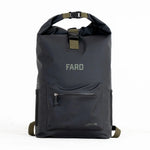Many people think that surf shooting is easy. You just fix your apparatus, take a few shots, and magic happens. Reality is a little different. Surf Photography is an art. Good surf photography speaks for itself. In this article, we've broken down everything you need to know to step into the world of surf photography. Let's get right into it!
What Equipment Do You Need?
Camera
You don't need a high-end camera to get good results. While it's undeniable that having a professional camera would garner better results, a reliable DSLR or mirrorless camera with interchangeable lenses is more than sufficient for beginners. Experiment with different settings and techniques with your camera and figure out a photography aesthetic that is true to you.
Long Lenses, Tripods, and Monopods
A telephoto lens will help you capture the most stunning pictures from the safety of land. A long lens, such as a 70-200mm or a 100-400mm, is a perfect option for beginners. It allows you to zoom in on the action, capturing details and expressions from a distance. These lenses are extremely easy to carry and provide high-quality results.
A tripod or monopod will stabilize and help eliminate camera shake when shooting with longer focal lengths. They'll free up your hands and help you easily carry the heaviest of gear!
The Best Camera Settings for Surf Photography
Once you have your camera and equipment ready, it's time to explore the ideal camera settings for surf photography. While there is no one-size-fits-all approach, adjusting your camera settings based on the conditions and desired outcomes can improve the quality of your images.
Shutter Speed
When capturing a surf moment, you want everything to look crisp and focused. A faster shutter speed, such as 1/1000s or higher, helps freeze the fast-paced action and the crashing waves, resulting in sharp and dynamic photographs. Slowing your shutter speed down can be used to take pictures in a completely different style, with blurred edges and wispy shadows
ISO
The ISO setting dictates the camera's sensitivity to light. Use a lower ISO, like 100, in bright conditions to produce images with minimal noise and maximum image quality. In low-light situations, increase the ISO gradually to balance exposure while keeping noise to a minimum.
Aperture / F-Stop
The aperture, also known as the f-stop, controls the depth of field. For surf photography, a higher f-stop, like f/8 to f/16, is recommended to ensure a larger area of the frame is in focus, including both the surfer and the wave. Higher f-stop also helps keep the photo sharp even if it loses some focus!
Learn the Movement
Before you jump into taking photos, take your time and learn about the movements of surfers and the ocean. By understanding these basic principles, you'll be able to anticipate the direction of the waves, the timing of pop-ups, and the best positions to capture pictures.
Experiment With Composition
Beyond mastering camera settings, composition plays an important role in creating visually appealing surf photographs. Experimenting with composition techniques can help you achieve a well-balanced and aesthetically pleasing image.
Know the Rule of Thirds
The rule of thirds is a basic composition technique that involves dividing your frame into nine equal segments using two vertical and two horizontal lines. Placing your main subject or points of interest along these lines or at their intersections can create a more engaging and balanced composition.
Leading Lines and Symmetry
Using leading lines, such as the shoreline, waves, or even a surfer's board, can guide the viewer's eye through the image and create a sense of movement. Symmetry can add depth and visual interest to your photographs, enhancing the overall composition.
Use Composition to Tell a Good Story
Photography is not just about capturing a moment but also about telling a story through what you see in the lens. By using composition techniques, you can convey emotions, capture the energy of the surfers, and transport viewers directly to the surf scene.
Capture Emotions and Expressions
Focus on capturing the emotions and expressions of the surfers to bring a human element to your photographs. Whether it's the determination in their eyes, the exhilaration of catching a wave, or the joy of riding it, these candid moments can add depth and personality to your images.
Where to Start Shooting Surf Photos
There are two primary ways to capture those incredible surfing moments - from the land or the water. Shooting from the land offers beginners a safer and more accessible option. It allows you to stand on solid ground while observing the surfers, the waves, and the surrounding scenery, making it easier to frame your shots and get a feel for the sport. You can experiment with different settings and learn how to time your photos.
Practical Tips
Beyond understanding the technical aspects, here are some practical tips to help you capture stunning surf photos:
Know the Surf Spot
Research and familiarize yourself with the surf spot you plan to photograph beforehand. Understand the wave patterns, tide timings, and the best vantage points to capture the action.
Shoot During Golden Hours
The sun is a photographer's best friend. The golden hours, the first and last hours of sunlight, offer the most beautiful and warm lighting conditions for photography.
Experiment
Don't be afraid to experiment with different angles, perspectives, and compositions. Try shooting from higher or lower ground, incorporating elements from the environment, and using leading lines to guide the viewer's eye.
Learn to Anticipate
Surfing is a fast-paced sport, and capturing the right moment requires anticipation and timing. Observe the surfers' movements, anticipate their actions, and be ready to press the shutter when the perfect moment arrives.
Take Care of Your Gear
Surf photography involves shooting in challenging environments, including sand, saltwater, and harsh conditions. Protect your camera and equipment with proper covers and cleaning supplies. Invest in protective gear for both your camera and your board to make sure they stay by your side for the long run.
-
Camera protection: Experiment with different underwater housing. Ask fellow photographers and thoroughly research the best housings for in-water maneuverability and functional use.
-
Self-protection: Practice maintaining your balance in the water while managing the hefty camera equipment. Use a wetsuit to prevent injuries like bruises or lacerations.
-
Board protection: Keep your board safe from dings, scratches, or UV rays by getting high-quality surfboard bags like the ones offered by FARO. These surfboard cases and longboard bags are made from durable material to keep your gear safe in any environment.

Conclusion
In conclusion, surf photography is a thrilling and rewarding endeavor that allows you to freeze epic moments and share the beauty of this sport with others. Practice your angles and figure out camera settings that suit you best. Share your work with others and act on any constructive criticism that you receive. And last but not least, remember to always have fun!





